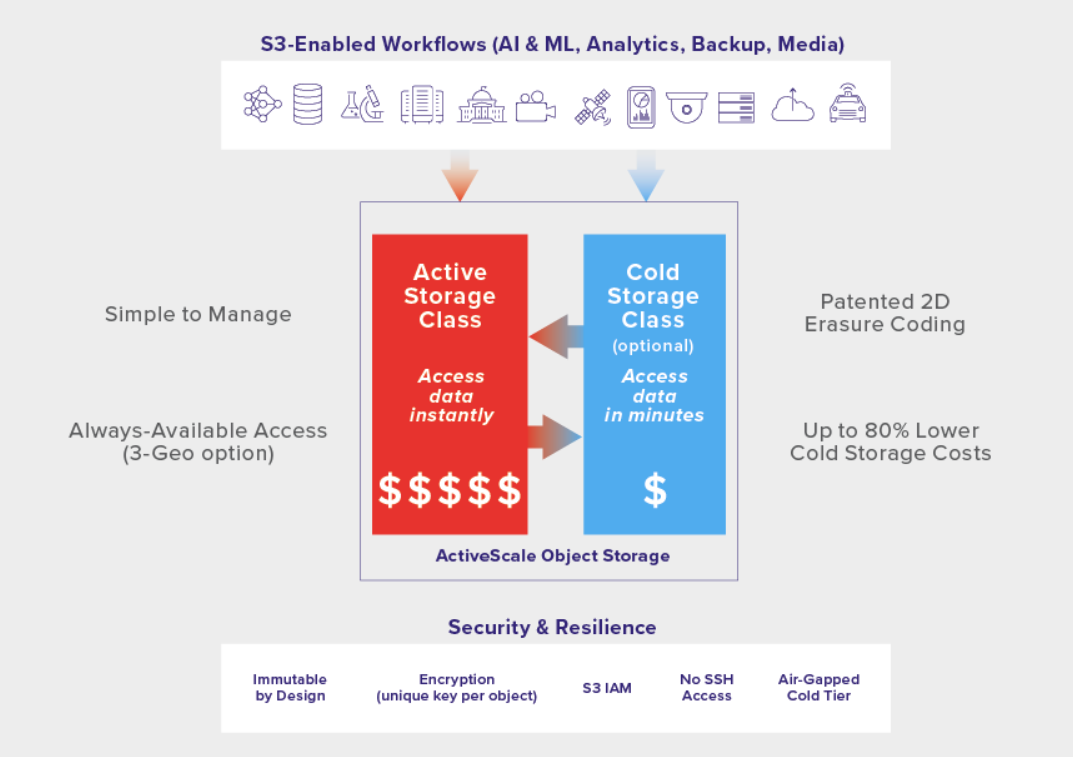Quantum has updated its ActiveScale object storage platform, significantly improving access to cold data in Glacier-class archive tiers. This update features an exclusive Ranged Restore capability for tape-based cold storage, using Quantum’s patented erasure-coded object-on-tape design.
Along with a new restore engine optimized for small-object performance, these changes transform tape archives from slow, offline storage into responsive, API-accessible data lakes ready for AI, analytics, and high-performance computing.
ActiveScale now allows customers to retrieve only the byte ranges they need from large objects, rather than rehydrating an entire file. This selective restore changes the economics and the experience of cold storage. Teams working on AI training, data validation, or compliance queries can access the exact segments they need to complete tasks without the delays and resource costs associated with full-object retrieval. This reduction in wait times and egress impact speeds up workflows and improves infrastructure efficiency across compute clusters and networks. Quantum notes that this is a custom S3 Glacier extension, unique to ActiveScale, for tape-based cold storage, addressing a longstanding issue in archive usability.

Supporting Ranged Restore is a new restore engine that boosts throughput for small-object operations by more than five times, thanks to intelligent batching and request ordering. Many AI and analytics tasks require high-volume access to small files, like label shards, feature indices, or compliance metadata scans. Traditionally, cold tiers have caused delays for these tasks. With ActiveScale’s performance improvements, small-object restores occur more quickly, enabling faster iteration cycles, higher job concurrency, and better utilization of GPU and CPU resources. The overall effect is a cold tier that functions more like a warm analytical layer for targeted retrievals.
Quantum’s leadership presents the update as a way to enhance value extraction from archives. Hugues Meyrath, CEO of Quantum, emphasizes that the key issue is not whether archives will grow, but how fast organizations can access the right data for training and analytics. He points out that waiting hours or days for data can hurt productivity and increase costs. The new ActiveScale features make large, long-term archives more accessible and AI-ready at the exabyte level.
Geoff Barrall, Chief Product Officer, adds that cold data should no longer be seen as offline. By removing the limitations of traditional Glacier-class storage, ActiveScale turns tape storage into a fast, standards-driven asset that can be queried programmatically and integrated into high-throughput data workflows.
The differentiation relies on three main aspects, including:
- Selective retrieval at the byte-range level reduces the time-to-first-byte for large objects and minimizes unnecessary data movement, resulting in lower egress, compute, and energy costs.
- The improvement in small-object performance addresses a significant pain point in AI and HPC pipelines, where accessing millions of small files has historically conflicted with the latency of archive-tier storage.
- The design maintains S3 compatibility while extending Glacier semantics in a manner unique to Quantum’s object-on-tape approach, enabling customers to modernize cold-tier access without redesigning their applications.
The core of ActiveScale’s erasure-coded object-on-tape design is crucial. Erasure coding protects data durability across media while allowing parallelism during restore operations. By intelligently managing reads and ordering requests to optimize tape motion, ActiveScale reduces mechanical overhead and turns sequential media into a usable layer for selective, high-throughput retrieval. The result is a cold tier that can participate in real-time or near-real-time pipelines, supporting training jobs, populating feature stores, and meeting targeted eDiscovery and compliance requests without the traditional operational costs associated with tape.
These updates aim to increase productivity across data engineering and MLOps. Faster, targeted restores allow teams to validate datasets, rerun training with updated samples, or perform audits with minimal disruption to ongoing jobs. Workflows that previously required staging data in a warm tier can now bypass intermediate steps in many scenarios, streamlining pipelines and reducing infrastructure clutter. For organizations managing multi-petabyte to exabyte archives, this consolidation results in lower total cost of ownership while keeping long-term data retention costs manageable.
From a governance and risk perspective, making archives “query-ready” meets rising expectations for data availability, lineage, and reproducibility. With selective access and improved throughput, companies can store data in a cost-effective cold tier while still meeting the responsiveness required by internal deadlines, regulatory requirements, and AI testing schedules. This approach also reduces the risk of retrievals by limiting the amount of data accessed, thereby lowering egress exposure and simplifying access control.
Quantum sees these capabilities as strengthening ActiveScale’s position as a versatile, future-proof platform for cold data. By transforming archive-tier storage into a fast, selectively accessible layer, ActiveScale enables companies to unlock the value of their data, regardless of age or volume. The platform’s Glacier-compatible API, along with unique tape-aware extensions, provides a practical way to integrate cold storage into AI and analytics without requiring a switch to different platforms.
These enhancements are available now.




 Amazon
Amazon